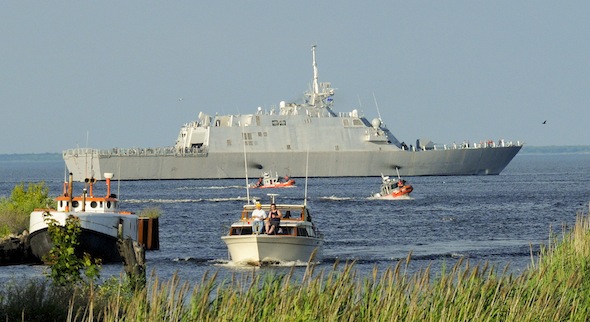
The U.S. Navy’ plans to base four Littoral Combat Ships (LCS) in Singapore. The lead ship of the LCS class, USS Freedom is expected to embark on a 10 month demonstration deployment to the area in 2013. The US Navy is hopeful that through this first deployment to the Southeast Asian Theater it will gain essential experience relevant for the development of concept of operations (CONOPS) for the new class of ships. Singapore officials specifically asked the Navy to deploy the LCS in the island state. The Navy now has two Freedom class vessels (video) and a single Independent class LCS. Ultimately, the Navy plans to build 55 LCSs, with construction split between the Lockheed Martin team and Austal. “LCSs will be an important part of a more agile future fleet,” Navy Secretary Ray Mabus said, noting the ships will allow for substantially more LCS forward presence than the frigates, Mine Counter-Measures ships, and coastal patrol craft they will replace.
The plan was endorsed in a recent meeting between U.S. Defense Secretary Leon E. Panetta and Singapore Defense Minister Ng Eng Hen. According the American Forces Press Service, the defense leaders discussed the planned deployment. The joint statement said the ships will be deployed on a rotational basis and will not be based in Singapore. The deployment signals U.S. commitment to the region, and enhances the ability to train and engage with regional partners, the joint statement said. The rotational deployments will be part of the U.S.-Singapore partnership documented in the 2005 Strategic Framework Agreement, Pentagon spokeswoman Navy Cmdr. Leslie Hull-Ryde said. “This marks a significant movement in terms of our cooperation with Singapore,” she added. “The specific details related to this unprecedented engagement are still being discussed.”
However, a recent report aired by the Project On Government Oversight (POGO) Claims that based on the ship’s history of design and equipment failure, the LCS is simply not ready to be deployed to Singapore, or to any other destination.
Overly praising the LCS program, the U.S. Navy has been reluctant to share documents related to the vessel’s vulnerabilities with entities such as the Pentagon’s Office of the Director of Operational Test and Evaluation (DOT&E). But POGO has obtained documents that indicate that the Lockheed Martin’s USS Freedom (LCS-1, the first LCS ship) has been plagued by flawed designs and failed equipment. Since being commissioned, it has at least 17 known cracks, and has repeatedly been beset by engine-related failures.
During the approximately two-month deployment in 2010 when the ship traveled from Mayport, Florida to its home port in San Diego, California, there were more than 80 equipment failures on the ship. These failures were not trivial, and placed the crew of the ship in undue danger. For example, on March 6, 2010, while the ship was in the midst of counter-drug trafficking operations and reportedly “conducted four drug seizures, netting more than five tons of cocaine, detained nine suspected drug smugglers, and disabled two ‘go-fast’ drug vessels,” The Navy release did not mention that during that mission, electricity went out on the entire ship, temporarily leaving the ship adrift at sea POGO reports.

Before and during the ship’s second set of rough water trials in February 2011, 17 cracks were found on the ship, according to the Navy’s Crack Monitoring Survey During Rough Water Trials Period #2. Some of these were quite serious and indicative of significant design failures. For example, a crack over 18 inches long was found at the corner of the deckhouse near a bi-metallic strip that binds the ships aluminum deckhouse and steel hull together.
Another crack was discovered “below the waterline and is currently allowing water in… When discovered there was rust washing onto the painted surface. It is thought this is rust from the exposed crack surface. It is unknown how long this crack existed prior to being discovered.
These cracks are not without their consequences. In addition to allowing water to leak into the ship, the cracks severely limit the ship’s top speed, which was previously touted as exceeding 40 knots. Last May, the LCS program manager issued near term operating guidance for LCS-1, which placed significant constraints on the ship’s Safe Operating Envelope (SOE).
According to the Near-Term Operational Guidance memo (enclosed), “there is risk associated with operating LCS 1 at the extreme edges of its SOE while transiting or deployed at significant distances from/to port (open ocean transit). Specifically, the new guidance states that in rough water the ship cannot travel at speeds greater than 20 knots. Even in calmer these faults limit the Navy’s “cheetah of the seas” to freighter speeds.
Lockheed martin responded “These reports cited by POGO are based on selective information that is more than a year old. As the lead ship in a totally new class, the USS Freedom is providing important lessons that are being incorporated into future ships, and the Navy and contractors extensively test these lead ships purposely to obtain this insight only available through usage.
USS Freedom has been certified and approved by both the Navy and the American Bureau of Shipbuilding. Solely focusing on isolated incidents on this first ship misrepresents the nearly decade of experience and knowledge Lockheed Martin now has building and maintaining these ships. Any issue that has arisen in the development, testing and usage of this lead ship has been, or will be, addressed to ensure she and future Freedom-class ships meet or exceed the Navy’s needs. And our overall LCS program remains on cost and on schedule.” Lockheed martin LCS Team commented.<a id=”video” name=”video”>

















